Canon
Digital Rebel T2i
Review & Photos
By Jim Zimmerlin

Canon
|

|
Here are some digital photos taken with my
|
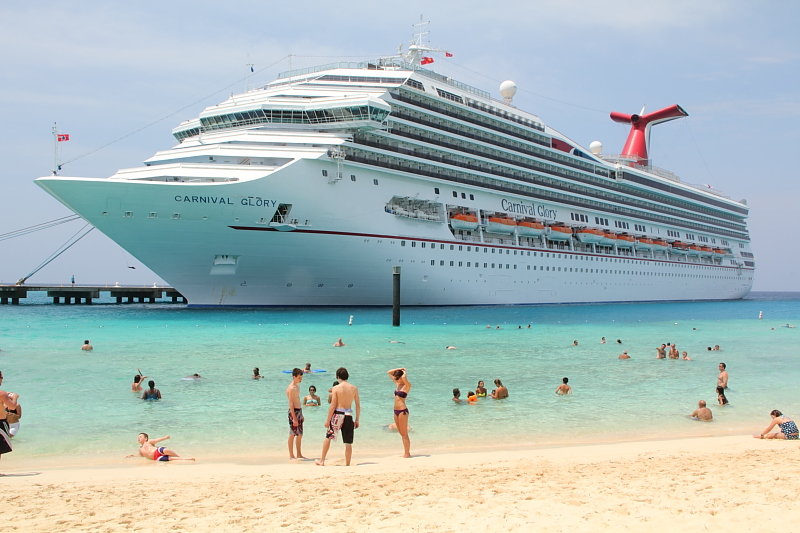 The Carnival Glory cruise ship at Grand Turk Canon EF-S 18-135mm image-stabilized lens |
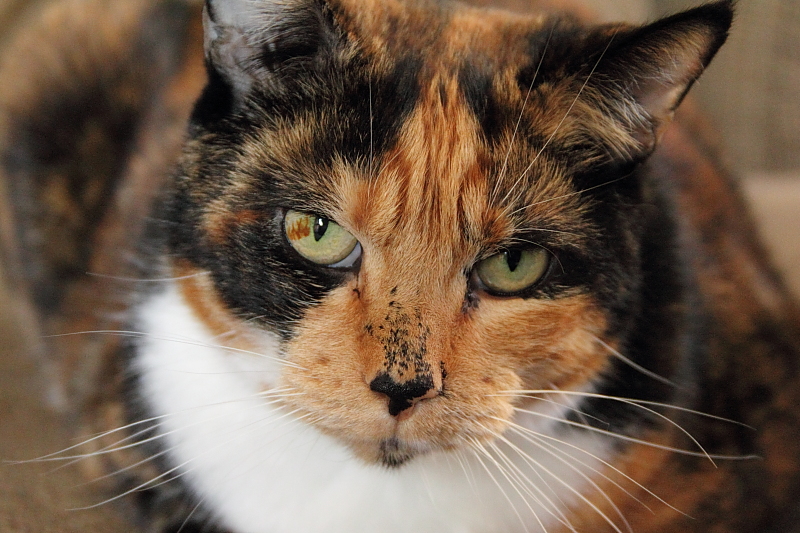 My daughter's very colorful cat Canon EF-S 18-135mm image-stabilized lens |
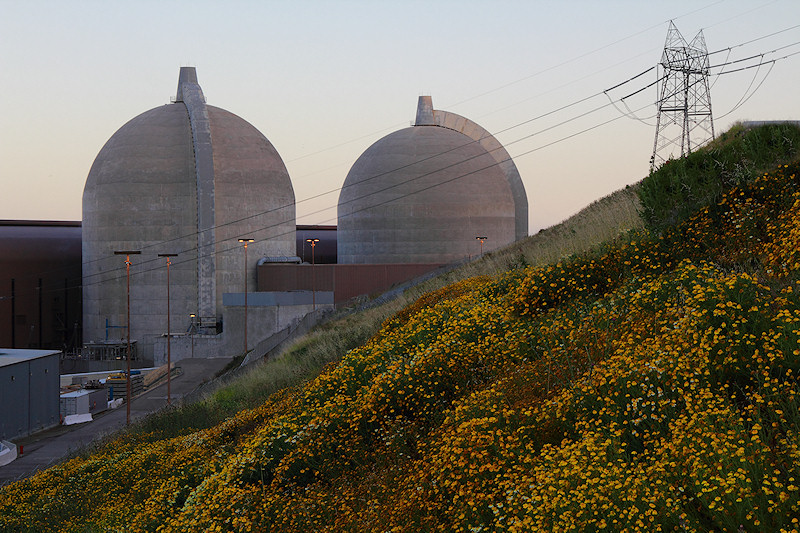 Wildflowers at the Diablo Canyon Nuclear Power Plant Canon EF-S 18-135mm image-stabilized lens |
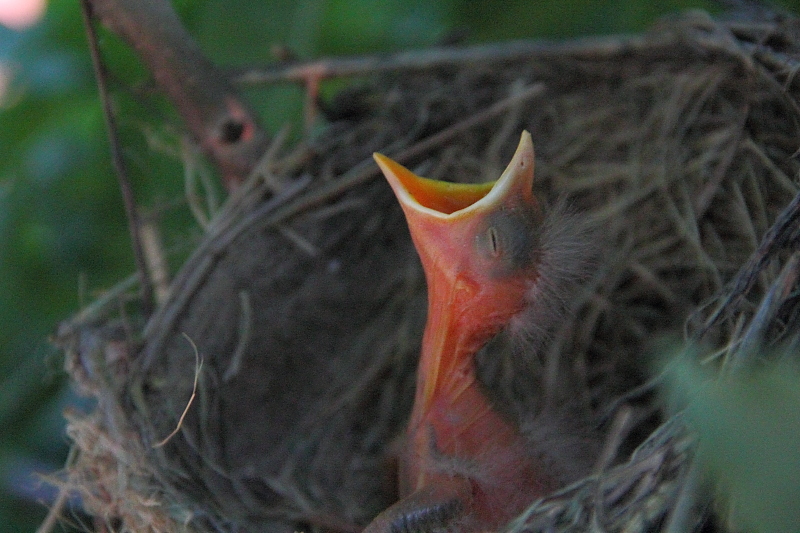 A 1-day-old baby bird Canon EF-S 18-135mm image-stabilized lens This photo was taken by my niece, Kindra Klaustermeyer. The photo was taken in very limited light at 6400 iso. It's a great example of how well the T2i works in low-light at high iso settings. Upon close inspection, you can certainly see the graininess in the photo from using such a high iso setting but it's a very acceptable amount of graininess as far as I'm concerned |
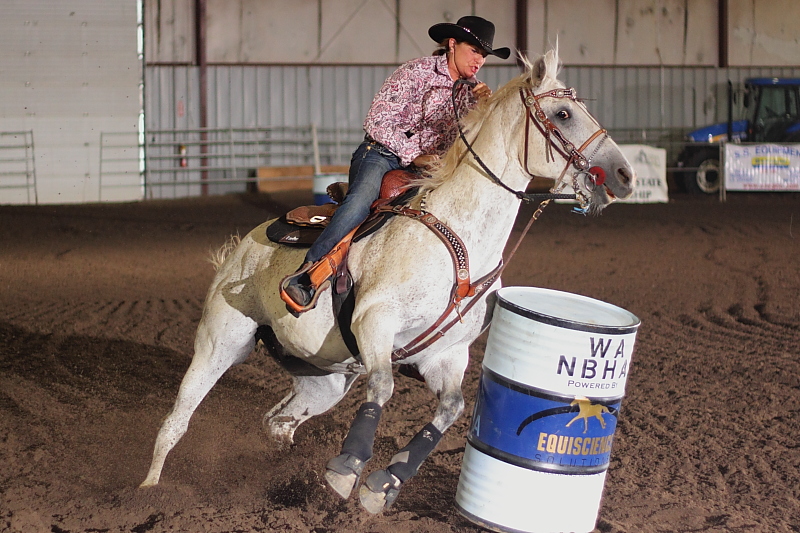 Barrel Racing Canon EF 50mm f/1.8 II lens Another high-iso demonstration shot... this was taken at 1600 iso. Do you see any graininess in this shot whatsoever?!? (And no, I did not use any post-production noise reduction tricks.) And the most amazing thing about this shot is that it was taken with the least expensive lens in my camera bag! I used the $99 "nifty fifty" 50mm lens for this, because it has the ability to open up all the way to f/1.8 (which is very useful for indoor sports shots) |
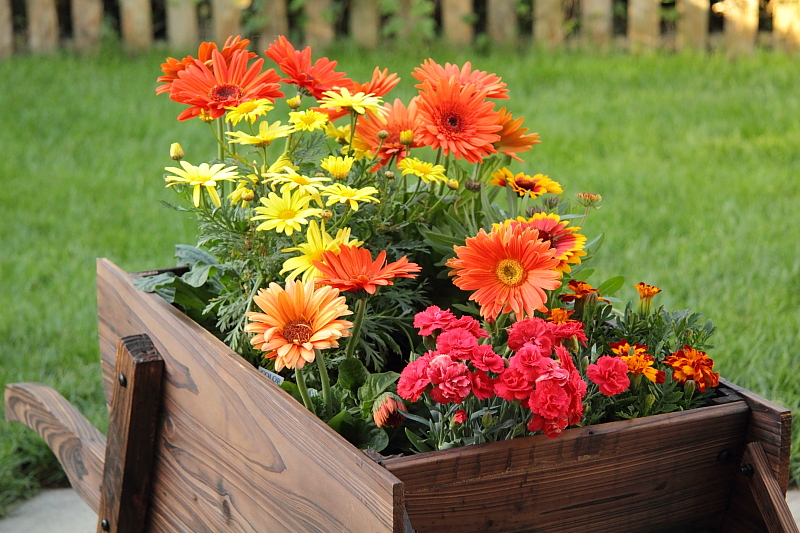 Flowers In My Back Yard Canon EF-S 17-85mm image-stabilized lens |
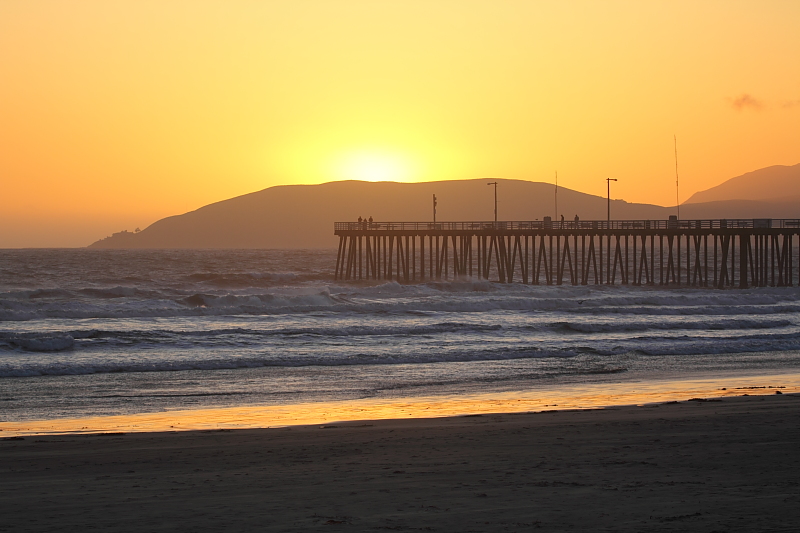 Sunset at Avila Beach, California Canon 100-400mm "L" series lens That is what I would call razor-sharp autofocus |
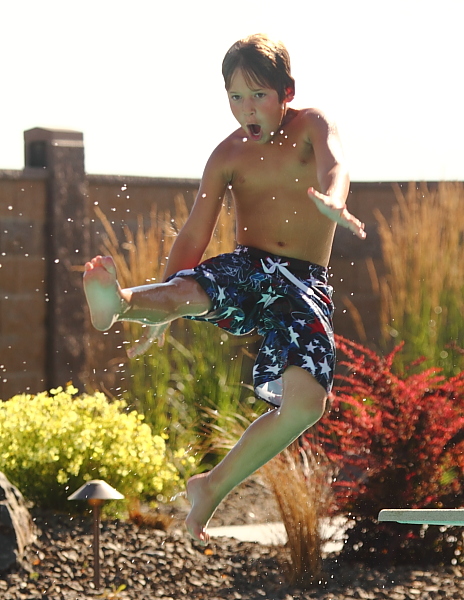 My Nephew, Carson, Running Off The Diving Board Canon 100-400mm "L" series lens When you mount the big zoom lens on the Digital Rebel, you can get some amazing photos without having to be very close. I was sitting under an umbrella on the far other side of the pool... shooting photos of my niece and nephew having fun. I set the camera to shoot at 1/400th of a second so that it would freeze the action... and wow, it sure did! If you want to take photos of your kids participating in sports... this is the camera to get. |
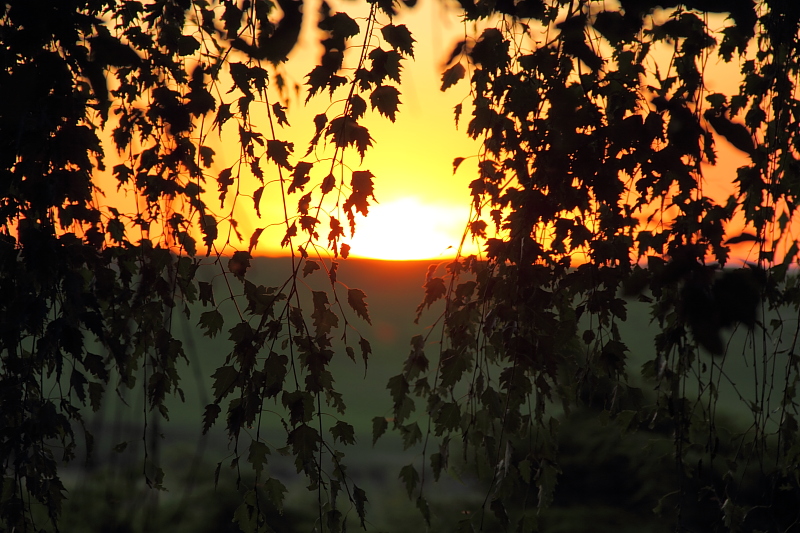 Sunset Through The Leaves Canon EF-S 18-135mm image-stabilized lens This photo was taken by my niece, Kindra Klaustermeyer. I was giving my niece a photography lesson and used the sunset as a teaching opportunity. I asked her to shoot a bunch of different pictures of the sun setting, in a variety of styles. I suggested she just experiment with shooting it many different ways. When she was done, she had taken 15 different sunset photos. I had her review the photos on the LCD on the back of the camera, and asked her to pick her favorite. This was it. And I think she definitely nailed it! |
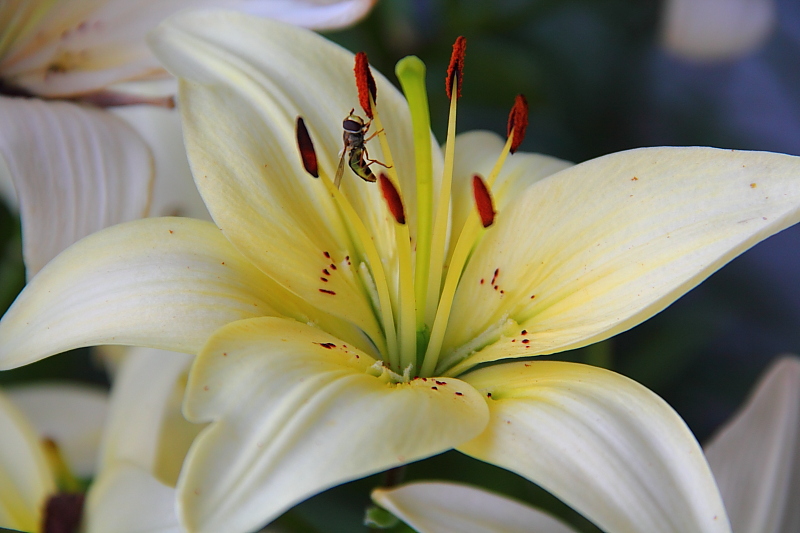 A Yellow Jacket Looks For Pollen Canon EF-S 18-135mm image-stabilized lens This photo demonstrates that (with the right lens) the Digital Rebel can get some great macro photos. |
Want to see pictures I've shot with other digital cameras?
Check out the Jim Zim photo gallery
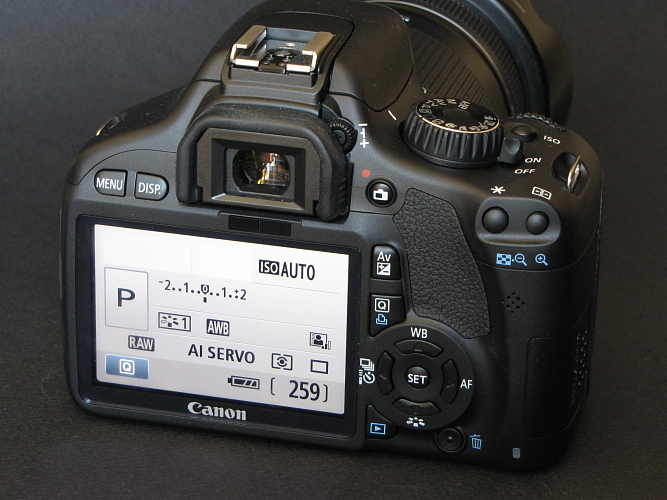
This camera is known in the USA as the Digital Rebel T2i. In some other parts of the world, it is known as the EOS 550D.
In 2003, Canon revolutionized the digital camera world by introducing the first under-$1000 digital SLR camera... the original Canon Digital Rebel. Ever since then, they've been improving the technology... and just about every year they've come out with a new model with all the latest enhancements. In 2005, the Digital Rebel XT was the latest and greatest. The next year it was the XTi. In 2008, they made a big jump forward with the XSi. The 2009 model, the T1i, was the first with video... and in 2010 they finally offered high definition video when they brought out the T2i.
This T2i Digital Rebel offers extremely high-resolution images. The images are 5184x3456 pixels... or 18 megapixels. As I mentioned, the T2i is the first Digital Rebel to offer HD video... and that was the main reason that I upgraded from the Rebel XSi. I've got two really nice 50" high definition TVs in my house, and it's great to have a camera that can capture video with the same quality that I'm used to seeing on blu-ray discs. This is not crappy low-resolution video like you get from most cameras these days... this is the real deal: high-definition 1080p movies that look fantastic on a good plasma or LCD television.
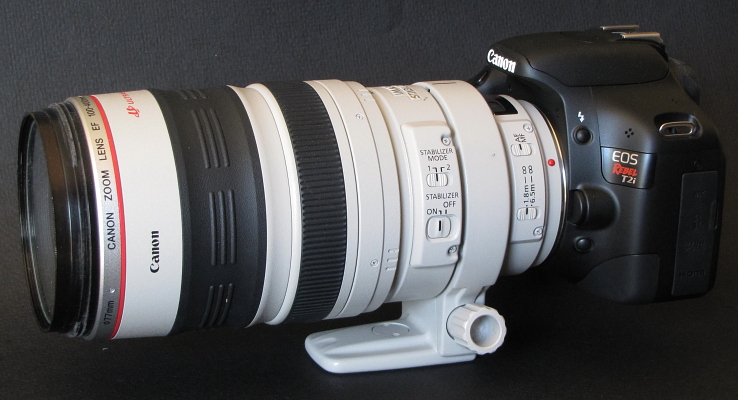
Canon Digital Rebel T2i with 100-400mm "L" series image stabilized lens attached
I've owned three different versions of the Digital Rebel over the years... the XTi, the XSi, and now the T2i. With each new version, Canon has managed to improve the low-light performance. It's absolutely incredible what the T2i can do in low-light situations without a flash. Let me show you an example. My son works as a Producer at KFMB-TV, the CBS affiliate in San Diego, California. I stopped by for a visit one day, and he gave me a tour of the station. Of course, I had to take some pictures! But when you're in that kind of a situation, it would be really un-cool to use a flash. Taking flash photos would bother the people who are working in the room, and it would draw a lot of attention. In that situation, a photographer wants to be as unobtrusive as possible. So... no flash... you've got to shoot in natural light. The problem is that behind the scenes of a TV news operation, there isn't a lot of light! So, your camera has to be really good at shooting at high iso settings. This is something the T2i excels at! Let me demonstrate, by showing you this photo I took in the control room of the TV station under very low-light conditions...
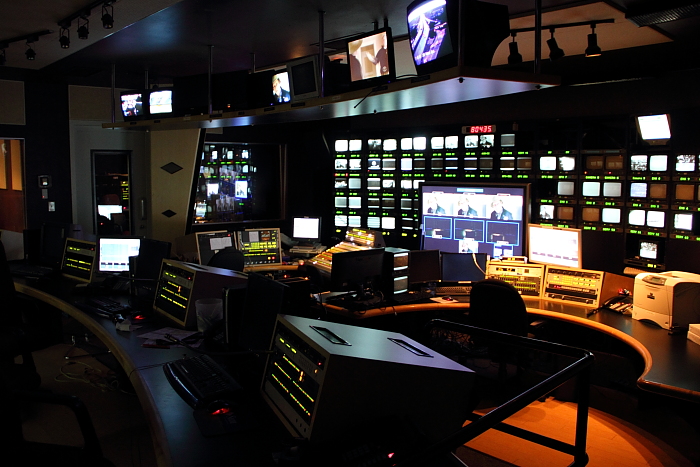
KFMB-TV control room - shot at 1600 iso, 1/6 second exposure, camera handheld
Absolutely no post-processing was done to this photo to reduce noise!
There was very little light in that room, but the T2i was able to get the shot because it is able to shoot at very high iso settings. That particular shot was at 1600 iso. If you've got a lot of experience with photography, you know that shooting at 1600 iso with most cameras will yield a terribly grainy (noisy) picture. But look at that control room shot! Do you see any noise? By the way, I didn't use any tricks such as post-production noise reduction or anything like that on the photo. The camera is just that good. One thing I did have going for me was that I was using an image stabilized lens, which allowed me to shoot at a much lower shutter speed than I would normally be able to shoot at. I was not using a tripod... it was a normal hand-held shot... but because I knew my lens had an image stabilizer, I was able to set the shutter speed to 1/6 of a second in order to make the most out of the very low light in the room. Have you ever seen a shot that was taken hand-held at that slow of a shutter speed that came out as sharp as that? That's what happens when you put an image-stabilized lens on a great camera like the Canon T2i.
There's a great feature on the T2i (and on the Rebel XSi, too) that can have the camera choose the appropriate iso setting for you automatically. Let's see if I can explain why this is one of my favorite little features. As I mentioned earlier, a few years ago I owned the Digital Rebel XTi. There were a lot of times when I was using the XTi that the camera simply refused to take the shot... because I had chosen too low of an iso setting for the shot I was trying to get. If you choose too high of an iso setting, you will get grainy looking photos... and if you choose too low of an iso setting, the XTi would just refuse to take the picture. But with the auto-iso feature on the Rebel T2i, this will never happen to you! This one simple feature is so incredibly useful. I could never go back to a camera without auto-iso now.
Of course, some things have remained the same in all of Canon's Digital Rebel cameras... they are compatible with the full line of Canon EF and EF-S lenses. Other standard Rebel features: the ability to shoot in "RAW" mode, which gives you the ability to make much higher quality adjustments to your photos than you can when working with .jpg images... a full range of shutter, sensitivity, and exposure adjustments... and there's an intelligent flash "hot shoe" on the top of the camera. I had a camera a few years ago that featured a cheap stripped-down hot-shoe. Canon's system is so much better! The camera and the external flash talk to each other and share exposure, shutter, focus, and white-balance information. It really makes for the best quality flash photos I've ever been able to take. Also, if you get the 580EX external flash, you have the ability to add a second less-expensive flash unit later, which you can place in another part of the room and the two flashes will fire together at the same time. This is called using a master flash and a slave flash.
In addition to shooting extremely high quality still photos, the T2i (or 550D, if you're outside of the USA) shoots great high-definition video, too. And I'm talking blu-ray quality video... in full 1080p resolution. If you buy the proper cable, you can hook the Digital Rebel right up to your HD television and play back your videos there. Or download them to your computer... edit them, if you wish... and upload to YouTube in full HD. (Or burn to a blu-ray, if you've got a blu-ray burner.)
Here are some HD videos that I've shot with my T2i. Please note, to see them in HD you will need to change the resolution of the video player (which is embedded below) from the default 360p to either 720p or 1080p... and it is suggested that you then set the video to play full screen. The buttons for resolution and full screen video are located at the bottom of the embedded player, just below the video window.
One thing to understand is that even if you use an autofocus lens, the T2i does not autofocus in video-recording mode the way you might expect. You can use the autofocus feature of your lens to set the focus of the scene before you start shooting, but it will remain focused at that same distance for the entire length of that video. In other words, it does not continually autofocus like a real camcorder does. So, if you're shooting a video of someone who is standing 6 feet away, and you set the lens to be focused properly for that... and then they start walking either closer or further away from you, things may get out of focus. In that kind of situation, an HD camcorder will work better for you than the T2i will. But as long as the focal distance doesn't need to change continuously on the things you shoot video of, the T2i does a great job.
The easiest way to watch videos that you've shot with your T2i is to connect the camera directly to your HDTV. Be aware that to do this, you need a special cable which is not included with the camera. The cable needs to have a standard full-sized (type A) male HDMI connector on one end, and a mini (type C) male HDMI connector on the other end. Whatever you do, don't go to a local retail store to buy this... you will pay way too much! Here's a link to an inexpensive one from Amazon.com:
I'd like to suggest an inexpensive lens that should be in the camera bag of every Canon Digital Rebel owner...
Canon's 50mm f/1.8 lens is a rare bargain in the world of Canon lenses. The reason that you want it in your arsenal is that f/1.8 rating. What that means is that this lens has an aperture that is open wide to let LOTS of light in... which makes this a fantastic lens for shooting in low-light situations. For example, if you want to do some shooting indoors in natural light without using a flash... this is the lens for you, because of that f/1.8 aperture.
At f/1.8, this is definitely the best low-light lens in my camera bag... and in addition to being very useful for indoor shots in natural light, a low-light lens like this is also great for shooting video. I've shot a lot of video with Canon T2i camera, and much of that has been with this 50mm f/1.8 lens on front of the camera. You get great video in natural light with this lens.
I still haven't mentioned the best part yet, though! You'd think a low-light lens like this would sell for a lot of money, but it doesn't! You can pick one of these up for just a little over $100. And that makes this the best bargain you'll ever find in the expensive world of Canon lenses. This lens even has a nickname among Canon fans. It's called "the nifty fifty"!
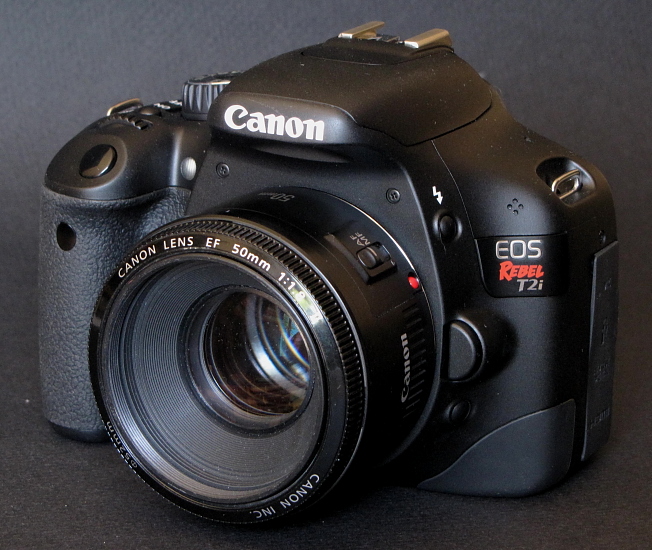
Canon EOS 550D (Digital Rebel T2i) with the 50mm "nifty fifty" lens mounted on front
If you're thinking that a inexpensive lens probably takes crappy pictures, think again!
Remember this shot I showed you earlier in the page? It was shot with the Nifty Fifty lens.

|
|
If you purchase a "nifty fifty" lens by clicking on this ad from Amazon.com they will send a small commission my way. Thanks! |
If you've been looking in to buying a Digital Rebel, you've probably noticed that Canon offers several models... the T3i, T2i, T1i, XSi, and the XS. I'll tell you right now that I think you should immediately rule out the XS. It's the lowest model in the line, and it's stripped down of some of the best features of the other Digital Rebels. Why pay hundreds of dollars for a camera and hundreds of dollars on lenses and other accessories and end up with something that is stripped down?
I'd also rule out the T1i. For one thing, it can't shoot true 1080p HD video like the T2i can... and if you've got an HD television, you're going to want to do this, someday. Maybe not at first, but someday you will. There really isn't a single feature on the T1i that would justify the extra cost over the real bargain in the Digital Rebel line... the XSi. In my mind, the real choice is between the T2i and the XSi. I used to own the XSi and then I sold it and upgraded to the T2i in the Spring of 2010 when the T2i first hit the market. So, I'm in a good position to be able to tell you the real differences between the two cameras. And it really boils down to one big thing... high definition movies. If you want to be able to shoot 1080p video with your Digital Rebel, get the T2i. If you really just want a camera for shooting still photos and you have no interest in shooting video... get the XSi. Sure, there are some other minor differences between the cameras... but none other than video that could possibly justify paying the additional cost between the XSi and the T2i.
The differences between the T3i and the T2i are really minor! The T3i has a swivel LCD on the back of the camera, which doesn't really come in handy very often... only in situations where you are shooting with the camera up above your head or way down low and can't just look at the LCD on the back of the camera. For example, shooting over a crowd by holding the camera way up high over your head... you can do that on the T3i, by swiveling the LCD to point down to where you can see it. I doubt many people need this feature. I don't! Unless you need this, rule out the T3i and go with the T2i.
So now for most people it comes down to a question of the XSi versus the T2i. It really comes down to this: are you planning on shooting video with this camera? If not, get the XSi. If you would like to be able to shoot video, get the T2i... because it can shoot video in full 1080p high definition which the Xsi cannot. So, for those of you who do not need to shoot video, click here to read my review of the XSi. Now in my case, I do want to shoot some high-def video to play back on my big HDTV... so I'm definitely a T2i kind of guy. But my guess is that a lot of people don't really need that, and they should get the XSi instead.
I've been extremely impressed with the Canon Digital Rebel cameras. I've taken some great photographs! I had already owned seven previous digital cameras when I decided to upgrade to the Rebel T2i, and it's been interesting to see how each camera has been better than the others.
There are lots of good reasons to go with a digital SLR camera over a traditional point-and-shoot digital camera. Without question, the end result... picture quality... is superior on photos taken with a digital SLR camera. It's great to be able to use interchangeable lenses... so you can use the right lens for the particular shot you are trying to get. As someone who tends to upgrade hardware frequently... it's nice to know that the Canon lenses I buy today will work with the Canon digital SLR cameras of the future. I don't think it's unreasonable for me to believe that I'll be using some of the lenses I have right now for the rest of my life. The best reason, though, is probably the reduction in "shutter lag" in digital SLR cameras. Anyone who's used a regular digital camera knows what I'm talking about... when you push the button, you want the camera to take the picture NOW! Also, if you put a good lens on a digital SLR camera, you'll find the autofocus feature works better than on any camera you've ever used before.
All this comes at a price, of course. Digital SLR cameras are a lot more expensive than point-and-shoot cameras... but the results speak for themselves. As someone who really loves photography, I think it's worth the money. The prices have definitely come down over the last few years, too.
|
If you appreciate that I took the time to create this web page to give you information about my experiences with the Canon T2i, and you're planning on purchasing one of these cameras, please do me a favor and make your purchase from Amazon.com by clicking on the ad over on the right side of the screen. Amazon will pay me a small commission for any products purchased after clicking on that ad... and that's the nicest way you can thank me for putting this information on the Internet for you. |
|
One of the great things about using a digital SLR camera versus a point-and-shoot is the hot-shoe which allows you to use an external flash unit. Most inexpensive digital cameras do not have a hot-shoe, so you're stuck with only the built-in flash. But when you get in to the world of digital SLR cameras, you have a hot shoe so you have the option of adding an external flash on to the top. You will find that you are able to get much better results in many situations where you are shooting indoors... especially if the room has a white ceiling you can bounce the flash off of. I use a Canon Speedlite 580EX external flash on my camera, and it makes all the difference in the world in the quality of my indoor photographs. The Rebel T2i is great at high iso photography, which means that in a lot of cases you can shoot indoors in natural light. But, this only really works well if the light in the room is very evenly distributed. In the real world, you tend to have very uneven lighting with a lot of shadows. So, a flash is quite helpful. If you just use the built-in flash, though, you get very strong un-natural looking light. You can get a much more natural looking soft lighting effect by using an external flash and not pointing it directly at the subject... you swivel it up towards the ceiling and let the light bounce off the ceiling and fill the room. This is called "bounce flash". If you're going to buy an external flash, make sure it can swivel! Some lower-priced external flashes can not. And make sure it can swivel both vertically AND horizontally, so you can bounce it off the ceiling regardless of whether you are shooting in portrait or landscape orientation! The Canon Speedlite 580EX is a good match for any Canon camera that can accept an external flash, and will swivel in both directions. |
|
Here's a demonstration of why an external flash is so useful.
Three photos of our neighbor, Natalie, using different lighting techniques:
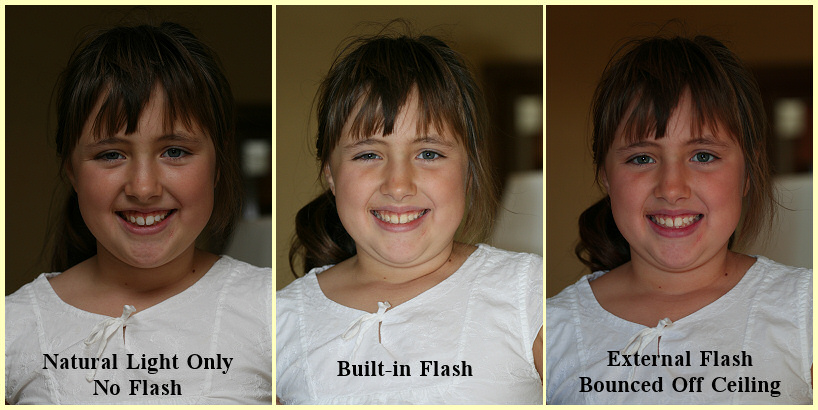
The one taken with natural light is not bad at all... there was a fair amount of light coming in through a window. The one using the built-in flash is horrible... the lighting is very harsh. You can see it actually made her squint. But the best photo of all is the one using the Speedlite flash bounced off of the ceiling. Look at the difference in the way her face is lit in that photo. If you're going for the best possible indoor photos, the Speedlite is worth every penny! If you purchase a Canon flash by clicking on the ad below, Amazon.com will send a small commission my way. Thanks.
Ready for another suggestion regarding accessories for the Digital Rebel?
My favorite accessory for the camera is the BG-E8 battery grip. It's great for several reasons. First off, it holds two Canon batteries at the same time... so you can go twice as long without having to worry about running out of batteries. Unless you are shooting thousands of pictures at one time, you never need to worry about whether you've got enough battery charge left when you have the battery grip attached to your camera.
Second, the battery grip features an extra set of camera controls that are oriented for vertical (portrait mode) shooting. Without the battery grip, when you rotate the camera to shoot in portrait mode, it's very awkward to reach the shutter release, for example. With the battery grip attached, the shutter release on the battery grip is in the perfect spot. It's also easier to hold the camera in portrait mode when the battery grip is attached. Finally, the camera just looks bigger and more professional with the battery grip attached. If you put the battery grip and a big zoom lens on your Digital Rebel, people may ask you what newspaper you work for!
Here's a picture of my T2i in the configuration I like best... mounted on top of the battery
grip, and with the 18-135mm image stabilized lens on the front. With those two batteries inside the grip, it can
shoot forever. And the battery grip just makes it feel and look so much better.
|
|
When you own an expensive camera like this, you need to protect it when you are lugging it around. Canon makes a great little carrying case... and it's just the right size for the Digital Rebel... even if you add on the optional battery grip.
| Finally, don't forget that Canon does not include a memory card in the box with the Digital Rebel. So, you'll need to be sure to get one... otherwise you won't be able to take any photos with your new camera! Each jpg image shot with the Rebel requires about 7 megabytes of memory space, and each RAW image takes up a whopping 29 meg... so I'd suggest you get a 16 gigabyte memory card so that you've got room for plenty of photos when you are on vacation and not able to download the photos to your computer for days at a time. If you're planning to shoot video with your T2i, do yourself a favor and get a 32 gigabyte card. |
There is a LOT more to this web site than just this page!
Please explore the rest of the site by viewing our table of contents,
or by clicking on one of the quick links below.
JimZim.net Main Page Meet Jim Zim Cruise Ships All About Our Cocker Spaniels